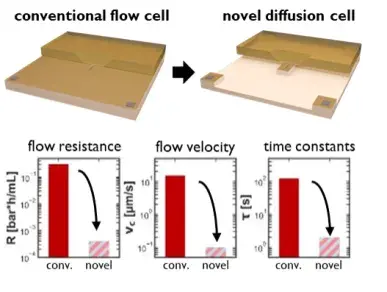Novel flow reactors for liquid-phase transmission electron microscopy (LPTEM)
By emphasizing diffusive transport, these reactors will enable quantitative in-situ and in-operando studies of diverse chemical and electrochemical processes at the nanoscale in liquid environment.

Liquid-phase transmission electron microscopy is a burgeoning experimental technique for monitoring nanoscale dynamics in a liquid environment, increasingly employing microfluidic reactors to control the composition of the sample solution. Current challenges comprise fast mass transport dynamics inside the central nanochannel of the liquid cell, typically flow cells, and reliable fixation of the specimen in the limited imaging area.
A team led by researchers of the Electron Microscopy group at CIC nanoGUNE have developed a new work in which they present a liquid cell concept – the diffusion cell – that satisfies these seemingly contradictory requirements by providing additional on-chip bypasses to allow high convective transport around the nanochannel in which diffusive transport predominates.
This achievement was possible thanks to the collaboration of Protochips, the Italian Technology Institute, the Polytechnic of Torino, the Donostia International Physics Center (DIPC), the Spanish National Research Council (CSIC) and Ikerbasque.
The results have been recently published in Nature Communications under the title "Toward sub-second solution exchange dynamics in flow reactors for liquid-phase transmission electron microscopy".
